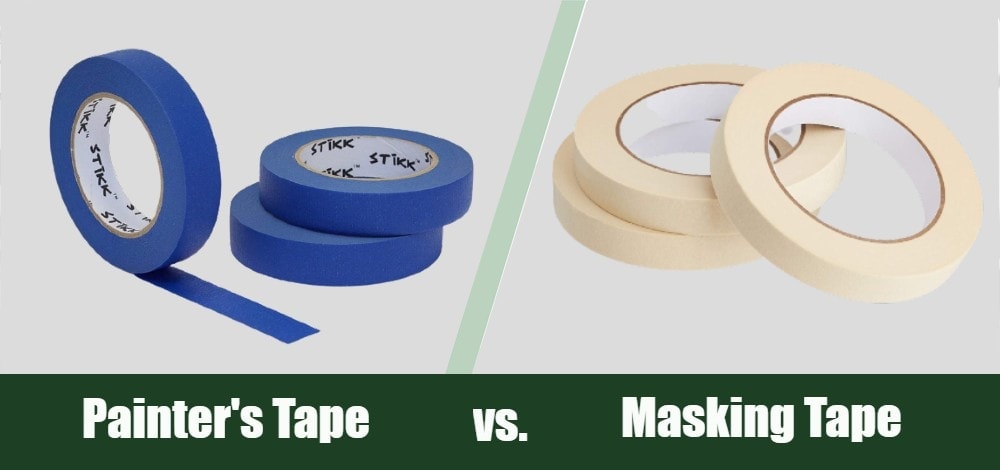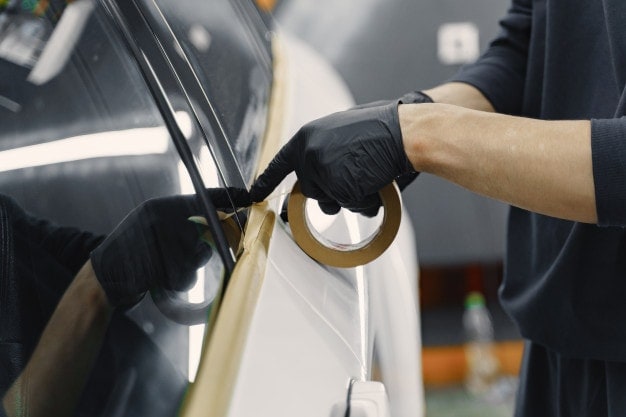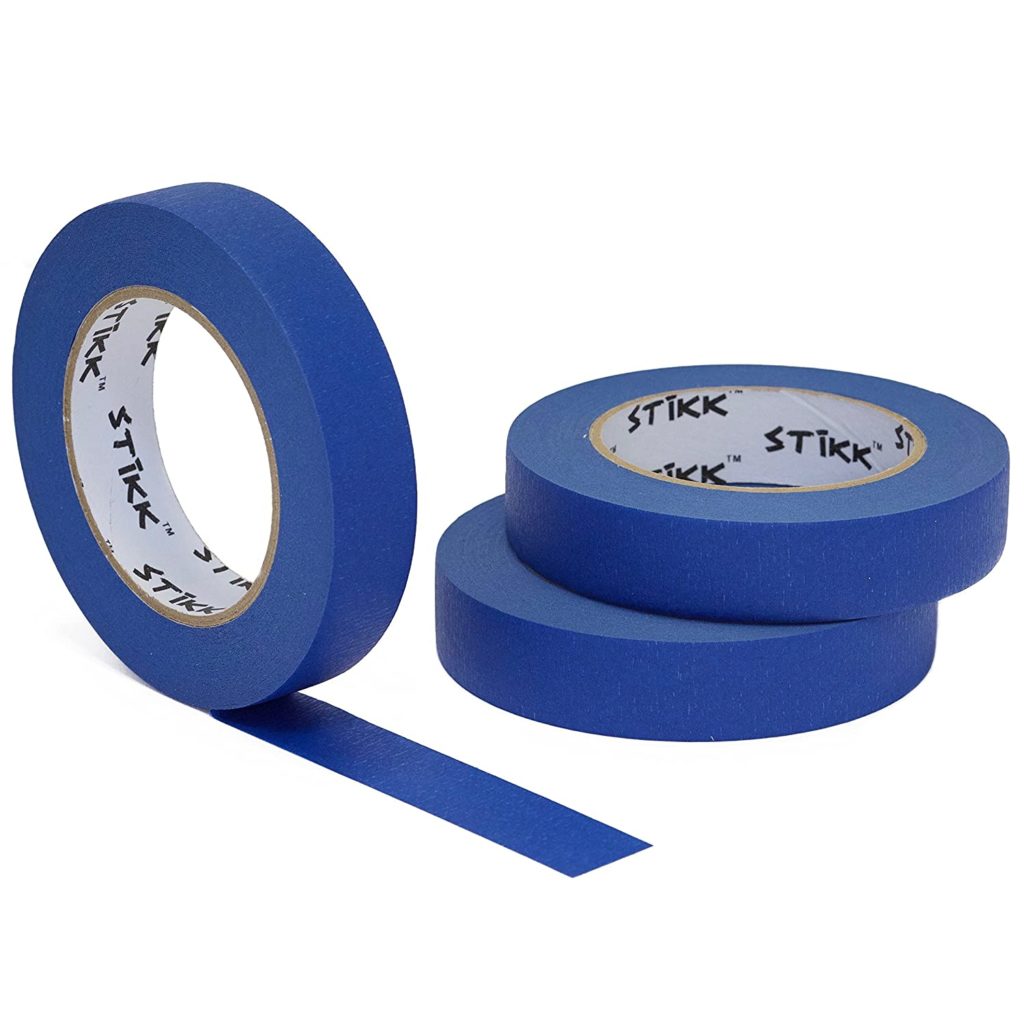Painter’s Tape vs Masking Tape: Which is Best for Your Needs?
-
Pete Ortiz
- Last updated:

For many DIY products, you will need tape. There are about as many types of tape as there are projects. You can find tape for just about anything. However, because there are many different options out there, there seem to be many similarities.
For example, painter’s tape and masking tape look very similar. If you already have masking tape in your junk drawer, you may think twice about purchasing painter’s tape. They just look so similar.
However, even if there isn’t a noticeable difference to the naked eye, there are a few minor differences between the painter’s tape and masking tape. They’re designed for specific situations, though there are admittedly a lot of crossovers.
Below, we’ll take a look at these differences so that you can choose the best option for your situation.
Overview of Painter’s Tape
Painter’s tape is usually a bold color, like blue or green. This helps it stand out against most paint colors. It is used primarily to create clean and crisp lines when painting. There isn’t any bleeding past the edge of the paint, and it is water resistant, so the wet paint won’t make it crackle – effectively removing the crisp lines you’ve created.
The adhesive on this tape isn’t super strong. However, that’s because it isn’t actually made to hold anything together. It will peel off easily without leaving any residue or taking any other paint with it. It is genuinely designed for painting and only painting.
Cost
The one major downside of painter’s tape is that it’s expensive. It is one of the most expensive options on the market, especially if you compare it to masking tape. While a single roll of painter’s tape may not seem pricey, it can add up over time. If you have a large paint job, you can expect to spend quite a bit of money on painter’s tape.
You’ll need to consider this cost in your budget.
Friendliness Towards Surfaces
You can safely use painter’s tape on the wall for up to 14 days without causing any problems. Of course, in most cases, you will not be using it for this long. However, if you do need to leave the painter’s tape up for several days, it shouldn’t cause any problems on the walls.
You can also use it safely on the ceiling, floor, or windows. It is designed to be very easy on all surfaces to have less touching up to do after painting.
- Will not damage surfaces
- Peels off easily
- Will not leave a residue behind
- Expensive
- Will not hold things together
Overview of Masking Tape

Compared to painter’s tape, masking tape is far more versatile. It has a decently strong adhesive, though it isn’t necessarily as strong as duct tape. For this reason, it can be used to keep small items together. It is also handy for things like making labels.
However, this tape is quite sticky. It is made to stay and not be pulled back off. Because of this, it will leave behind a residue when it is torn from a surface. When you’re painting, this can be a problem. The residue will build up quickly and be there for the foreseeable future.
If you aren’t planning on taking the tape off the surface, then this shouldn’t be a problem in the least.
But, if you’re planning on using the masking tape for painting, you will run into an issue with residue on the surface.
Cost
Masking tape is pretty cheap. It is much cheaper than painter’s tape and most other kinds of specific paints out there. In some cases, masking tape will be half the price of other tapes. When you’re using it over a large surface, this can save you tons of money. If you’re looking for something to keep around the house for small jobs, the lower cost might be a game-changer.
Friendliness Towards Surfaces
As we have already discussed, masking tape is very adhesive. This will cause a residue to be left behind when used for practically any time. Of course, the longer you leave it on, the more residue that will likely be left behind. For this reason, it doesn’t do its best when you plan on removing it.
Furthermore, it may pull paint off the wall and damage other surfaces because of its strong adhesive. This is essential to consider, especially if you’re using it on a surface already done. If you want the surface to look the same after using the tape, this likely isn’t the best option for you. You will need to do touch ups.
- Inexpensive
- Strong adhesive
- Versatile
- Will leave a residue behind
- Can damage surfaces
Price – Masking Tape vs Painters Tape
There is a significant price difference between masking tape and painter’s tape. The difference is significant, and it can add up if you have a large project. If you want to hold stuff together, then masking tape will be the better option in most cases. However, if you’re painting, then you’ll need to weigh the cost against the benefit of using painter’s tape.
The cost probably won’t be substantially different for small projects, so you’d be better off purchasing painter’s tape. However, for larger projects, the cost will vary quite a bit. However, it is oftentimes these projects that need painter’s tape the most.
Masking Tape vs Painters Tape – When to Use Which?
The main thing that will dictate what tape you need is your project. If you do regular DIY, you will probably want to have both of these tapes within arm’s reach. They’re both great at what they’re designed for and only moderately good at things they aren’t designed for.
Painter’s tape is designed for painting – hence the name. If you’re painting, it is your best option. It is designed to be pulled off easily and leave clean lines. Paint won’t bleed through it, and the tape won’t damage the surface after it is applied. In other words, this is the perfect tape for painting.
Masking tape is best for times when you need a lightweight adhesive. It is made to stick and stay stuck, so don’t use it on anything you plan to take the tape off of when you’re done (like painting). It has a decently strong adhesive and is suitable for small repairs. It is also suitable for label making and that sort of thing.
Masking Tape vs Painters Tape – What Are The Differences?
The differences lie mostly in the cost, adhesive strength, and surface friendliness.
Painter’s tape is more expensive – by quite a lot. It also doesn’t have a very high adhesion strength. However, that’s because it isn’t designed to stay stuck. Instead, it is made to stick to a surface and then be removed easily. For this reason, it is also friendlier to surfaces and won’t leave behind a residue.
Masking tape is a lightweight adhesive. It is designed to stay stuck, so it will leave a residue behind if you try to remove it. For lightweight repairs, it works perfectly. It is also useful when you want to stick stuff to the walls permanently, like labels. It may pull paint off, though, so be cautious when using it for an extended period.
Conclusion
When you’re painting, you should preferably use the painter’s tape. The painter’s tape is designed to be used for painting. It leaves cleaner lines and works better. On the other hand, for all other lightweight tasks, use masking tape. It is best for lightweight tasks when you want the tape to stay stuck. It doesn’t do well with getting pulled off, though, so it is best not to use it for painting. It will leave residue and can damage painted walls.
While the tape you use is mostly a matter of your project, they are designed for different uses. However, the cost may play a role too, as the painter’s tape is a bit costly.
Contents





